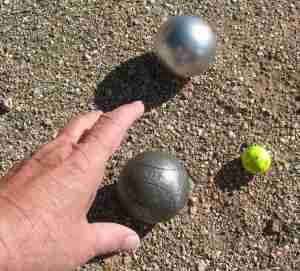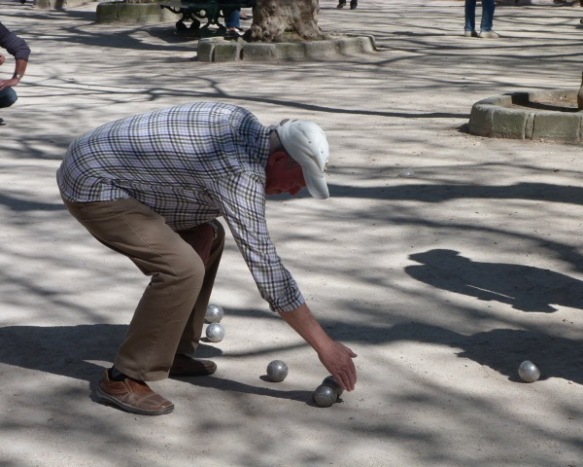There is something about this process that the FIPJP rules do not say, but that international umpire Mike Pegg has made clear in multiple answers on his “Ask the Umpire” Facebook forum— in order for this process to take place, the dead-ball string must be in its correct location.[1] The string’s correct location is the location where it was installed by authorized officials before the beginning of the competition.
Problems can arise if the string is not installed properly. Article 5 says that the string should be thin enough that it doesn’t affect the smooth running of the game, but in practice the diameter of the string is less important than the way it is installed. A string needs to be taut so it is straight, and it needs to be flush to the ground. If the surface of the terrain is irregular, with humps and bumps— hills and valleys, as it were—the string may stretch across low spots, suspended in mid-air like a bridge. In such cases, the string can be high enough above the ground to interfere with the movement of a rolling jack or boule. In this photo the string is far enough above the ground for the jack actually to be caught beneath it.

In such cases, a player can trip on the string, or a rolling boule or a player’s foot may catch the string and move it out of its correct location. And that’s when players start asking questions about what to do when the dead-ball string is moved.
There are two types of situations that raise questions.
- Something pushes the string out of place. The string then snaps back to its correct location, pushing a boule or the jack back onto the terrain.
- Something (typically a boule) pushes the string out of place… and the string remains stuck there, out of position.
Let’s look at some examples of the first type of situation. Something pushes the string out of place. The string then snaps back to its correct location, pushing a boule or the jack back onto the terrain.
A boule is moving toward the dead-ball line when it is caught by the boundary string. The string stretches and then, like a bowstring launching an arrow, pushes the boule back onto the terrain. In the scenario shown in the picture, did the ball cross the dead-ball line or not? What prevails— the string itself or the lane limit it represents? Is the boule dead or alive?

Here’s another example. This one involves the jack rather than a boule.
I was standing near the dead-ball line when my partner shot the jack. The jack flew toward me and in order not to stop it, I stepped back. My shoe caught the dead-ball string and pulled it back. The jack crossed the place where the string had been. When I lifted my foot, the string snapped back to its normal location, knocking the jack back in-bounds. Our opponents did not see this, and neither did the umpire. The umpire ruled that the jack was still good.

What these situations have in common is that the string was in motion throughout the incident. There was never a point in time when observers could visually compare the location of the ball to the location of the string in its correct location. Given that fact, all that players and umpires can do is to wait for everything to come to rest, and then compare the location of the ball to the location of the string. In both of these cases, the ball ends up inside the dead-ball string, so it is still alive.
Note that these situations are different from a situation in which a boule rolls across the string and then, because of a slope in the ground, rolls back in-bounds. In such a case, the string remains in its correct location. Observers can see the string and they can see the boule, and they can see that the boule completely crosses the string before rolling back in-bounds. The boule is dead.
In the second kind of situation, something pushes the string out of place, and the string remains stuck there, out of position.
In this photo we see that a boule has pushed the dead-ball string outward from its correct location. The jack is on the out-of-bounds side of the dead-ball string but still touching the string. 
The question is—Is the jack dead?
The answer is— We don’t know. We can’t tell, because we can’t compare the location of the jack to the location of the string when the string is in its correct location.
The solution to the problem is to put the string back into its correct location.
Then we can make a decision based on the locations of the jack and the string.
We need to be extremely careful when moving the string back to its correct location. In this case, we can’t move the string without moving the boule, so we mark the boule’s location. We then very carefully remove the boule, allowing the string to move back to its correct location. Then we compare the location of the jack to the location of the string.
Judging from the photograph, we will probably find that the jack is out-of-bounds and dead. However, if we discover that the jack is alive we return the boule to its marked location and carry on with the game.
Now that we know how to handle such situations, we can see how a variation of one of our earlier situations should be handled. In this case, the string is moved but it isn’t allowed to snap back into place. It is held out-of-place by a player’s foot.
I was standing near the dead-ball line when my partner shot the jack. The jack flew toward me and in order not to stop it, I stepped back. My shoe caught the dead-ball string and pulled it back. The jack crossed the place where the string had been.
Surprised, I froze in position. When the umpire arrived, he held the string while I extricated my foot. Then he carefully lifted the string over the jack and returned the string to its normal location. At that point the jack was clearly out-of-bounds and the umpire ruled that the jack was dead.
Finally, in a situation where the string was so poorly installed, Mike Pegg points out that there is one more thing to be done.[2]
The umpire is not responsible for the string line being tight or fixed down, although before the games started the umpire should have checked that everything was in good order. As soon as the end in question is over, the umpire should arrange with the venue organisation to have the line re-tensioned or fixed down.
FOOTNOTES
[1] See Mike Pegg’s reply to Rob Brealey (June 2, 2018) https://www.facebook.com/groups/128791213885003/permalink/1583415321755911/
Rob— What’s the ruling when team A is holding the point and team B shoot successfully but team A’s boule moves the dead ball line causing both boule to still be in?
Mike – I’m assuming the string is being prevented from returning to its correct position by one of the boules. In this case the string should be carefully moved to its correct position— without disturbing the boules— and then check to see if the boules have crossed the string. You should also fix the string so that it cannot be moved again.
See also Mike’s follow-up post https://www.facebook.com/groups/128791213885003/permalink/1584258958338214/
[T]he string line has to be in place to determine if the boule has fully crossed it….
[2] https://www.facebook.com/groups/128791213885003/posts/4553615681402512/


 But consider a different situation. In this situation A1 is closest to the jack, so Team A has the point. Albert is measuring A2 and B2 in order to determine which boule is second-closest. As before, Albert bumps a ball. Instantly A2, B2 and the jack are frozen into a triangle, with B2 closer than A2. Now the boules (in order of their distance from the jack) are A1, B2, and A2. Team A still has the point and so (unlike the previous situation) Team B plays the next boule.
But consider a different situation. In this situation A1 is closest to the jack, so Team A has the point. Albert is measuring A2 and B2 in order to determine which boule is second-closest. As before, Albert bumps a ball. Instantly A2, B2 and the jack are frozen into a triangle, with B2 closer than A2. Now the boules (in order of their distance from the jack) are A1, B2, and A2. Team A still has the point and so (unlike the previous situation) Team B plays the next boule.




